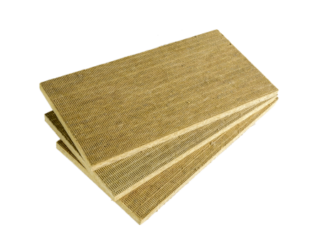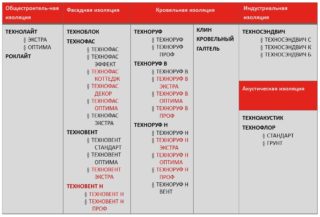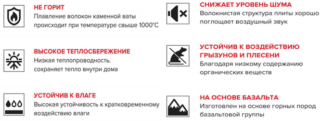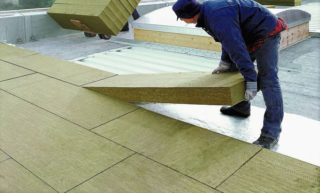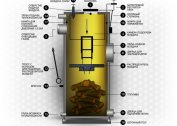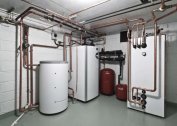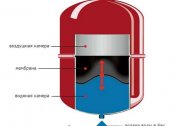Tile insulation Tekhnoruf is used for single and double layer roof insulation with or without screed. Hydrophobized non-combustible material is a type of mineral wool based on rocks. Insulation is produced in Ukraine by the Technonikol association and is sold in many countries.
Material Features
Raw materials are mixed according to the recipe and melted in containers at a temperature of + 1500 ° С. The mass rotates in a centrifuge, thin fibers form. The air flow carries the semi-finished product along the conveyor, resulting in a product of a given shape and size. The polymerization takes place at high temperatures; subsequently, water-repellent impregnation is done to hydrophobize the material.
The fibers are arranged vertically and horizontally in the structure, which helps them cope with point loads and restore their original shape. The location of the threads is set during the production by the corrugating and pressing machine.
The Tekhnoruf plate is resistant to high temperatures and chemicals, isolates the surface from cold and extraneous noise. Thermal conductivity depends on the density of the material and increases if water enters the thickness of the insulation.
Products are formed into rolls or cut into plates, packaged in bundles, protected by a plastic sheath. The material is protected from moisture during storage and transportation.
Types of insulation
Technoruf N Extra has a density of 100 kg / m3, it is used for the device of the lower insulating layer in a multilayer structure when warming a flat roof. Non-combustible material has a compressive strength of 30 kPa, thermal conductivity of 0.039 W / m · s.
Technoruf H 30 has a density of 115 kg / m3. Technical characteristics of Tekhnoruf N30 insulation indicate compression strength of 30 kPa and thermal conductivity of the material is 0.041 W / m · s. It is used as the first layer in case of two-layer insulation on reinforced concrete or profiled sheets, combined with Tekhnoruf V. panels
Technoruf 45 characterized by a density of 140 kg / m3, it is used in the form of a lower layer for multilayer insulation of the roof with the implementation of a protective dry or wet screed. The tensile strength is 45 kPa, thermal conductivity in the range of 0.038 - 0.041 W / m · s.
Technoruf Prof It has a density of 160 kg / m3, it is used as the main or upper layer in multilayer insulation. Strength at the level of 60 kPa, thermal conductivity 0.41 W / m · s.
Technoruf B 60 has a density of 180 kg / m3, it is used when arranging the last layer or as the main insulation material on roll roofs with or without screed. The tensile strength is 60-65 kPa, the thermal conductivity of the material is 0.041 - 0.043 W / m · s.
Technoruf Galtel represents the warming strips having a triangular section. They are made of basalt wool and are used for isolation at the junction of horizontal and vertical areas. Stripes 1.2 m long have legs 0.1 m long.
Technoruf N 30 Wedge produced in the form of plates with a slope equal to 1.7%. Scope - the area of the ramp on the roof to remove water.
Marking
Indices in the names of mineral wool boards carry information about the insulation. The numbers from 30 to 60 indicate the ability of the material to resist compression, the unit is kilopascal (kPa). Previously, the numbers were 80 and 50, but in the latest versions they are not used. In the name Tekhnoruf Prof, Extra, Optima there is no index, but their tensile strength corresponds to a given value of 60 kPa.
The letters indicate the laying parameters in the insulation structure:
- N - indicates the purpose in the lower layer.
- B - insulation is used for the upper layer.
Modifications that do not contain an alphabetic designation are used as the main material and are placed in 1 layer.
Specifications
Insulation is used in flat roofs and roofs with a slope, on reinforced concrete slabs, metal or roll base.
Main characteristics of the Tekhnoruf minplite:
- density in the range of 100 - 190 kg / m3;
- thickness from 30 to 100 mm;
- withstand concentrated load up to 600 N;
- compressive strength in the range of 30-60 kPa;
- vapor permeability for all species is not less than 0.3 mg / (m · h · Pa);
- combustibility category - NG;
- humidity in the mass is not higher than 0.5%;
- water absorption is not more than 1 - 1.5%;
- the presence of organic matter is not more than 4.5%.
Compressive strength is important for operating roofs, through which people are allowed to pass, and the installation of additional equipment. Humidity and the ability to absorb water affects the thermal insulation characteristics, because when wet, the conductivity of energy flows increases. The thickness of the material is selected depending on the climate and roof structure, but is more often used in accordance with the design documentation.
Pros and Cons of Material
The Ministry of Technology Tekhnoruf can withstand point loads, therefore it is used for operated roofs, it can be used to isolate walls and floors from the cold. The use of expensive material is justified only for thermal insulation of roofs and floors during reconstruction and new construction.
Advantages of insulation:
- the thickness of the insulating layer is reduced due to low thermal conductivity, therefore, with interfloor insulation, the height of the room is not lost;
- sudden changes in temperature, frosts do not have a destructive effect, thermal conductivity remains the same;
- when heated by the sun or in a fire, the material does not emit toxic carcinogens and is used in schools and kindergartens;
- after a short-term deformation, the insulation restores its original shape and size;
- the layer simultaneously serves as sound insulation and no additional layer is required;
- rodents do not settle in the thickness, fungus and mold do not breed;
- during a fire, the material creates a barrier to the spread of flame, as does not burn;
- mineral fibers repel moisture; in addition, special impregnation is used.
The disadvantages of insulation include high cost. After heating to + 300 ° C, the adhesive base melts and the plates lose their shape and properties.
Application area
Plates are placed for insulation of roofs of private houses and buildings. High thermal insulation ability allows the use of material for insulation of floors in unheated attics, summer attics. The insulation works effectively when isolating the ceiling above the basement so that cold from the soil does not penetrate the first floors of the house. The insulation is durable and is used as insulation under the screed or such a layer is not performed. Miniplates can withstand household loads.
The roofs of industrial buildings that are not in operation are also insulated with Tekhnoruf material. Structural elements of a certain cross-section allow the abutment of layers and joints in different planes. Plates are mounted after installation of air ducts, other roofing communications.
Insulation Installation
A vapor barrier membrane made of a film or a special material is placed on the roof surface. Plates are fixed to the base of the roof with dowels, the length of which allows you to fasten all the protective layers. After installing the panels in a checkerboard pattern, waterproofing is made according to the insulation.
A film or a high-tech membrane is glued to the surface of the thermal insulation, or a cement-sand screed is arranged. Bituminous or mastic coating is allowed as a protection against moisture. A reinforcing layer is used, for example, polyethylene mesh or strong fiberglass. Materials are fixed with adhesive. The interlayer increases the strength of the insulation to mechanical stress. The cellular material is installed with an overlap of the edges of 10 cm, after applying the adhesive, the layer is aged without load for a day.
Finishing screed is in progress. For an unexploited roof, this is where the finish ends, terraces or places of passages on the roof are additionally finished with paving tiles or other types.
